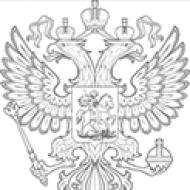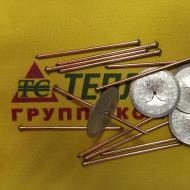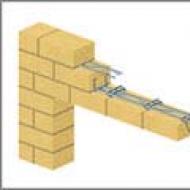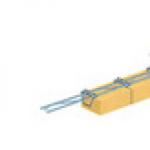
The payback period of capital investments with Excel loan. Comparison of payback projects
The investor, the meaning of the launch of projects, begins with simple questions, responding to which gradually clarifies the picture of the intended effectiveness of investments. The first question in assessing investment projects is related to the definition of the period for which the expenses return will occur. In other words, the domestic or external investor is interested in the payback period for specific design tasks formulated from strategic initiatives or the market proposed. Introducing payback, a decision maker to the zone of their attention should own the method of its calculation and navigate the limitations of the proposed time conditions.
Simple payback period
Determine the payback period of the project can be in several ways, the first of which is the easiest. This method refers to traditional statistical approaches that have arisen quite a long time and are based on the logic of common sense. The method is called "payback period without discounting", in English-speaking tradition derived from Pay Back (Return, pay off) is indicated as abbreviation - PP (PayBack Period).
This indicator is simple and accessible to understanding precisely as a period of payback period used for the implementation of the project by revenues generated as a consequence of investments. The indicator conditionally divides the duration of the investment project into two large parts: the period of return of investments and the period of recovery of the effect. Thus, the payback period is the minimum duration that is counted since the start of the project and is required to return invested investment resources.
As soon as the return took place, the integral effect of the project occurs, which further develops in a positive side, forming a financial result, for which, in fact, the investment process was treated. The payback period, calculated on a simple method, does not take into account the conditions for the dynamics of the cost of money and other means in time. In certain situations, this approach is completely correct. This method does not take into account the discounting effect. By the way, in definition given in federal Law № 39-ФЗ dated 25.02.99 "On investment activity at Russian Federationimplemented in the form "is considered precisely the payback period in simple form.
The payback period in a simple form can be made according to one of two possible approaches. The first approach proposes to calculate the payback period as the private between the amount of initial investment in the value of the average annual revenue money on the fact of project implementation. This approach has an indispensable condition to cash arrivals From year to year they were approximately equal, then the calculation will be correct.
The second approach is to calculate the cumulative accumulation of the balance of values cash income in comparison with the amount of attachments made. In addition to simplicity, this method has several more advantages:
- the size of the initial investment in the project is not difficult to establish;
- projects are easy to rank in payback periods, highlighting the most favorable to maintain business liquidity;
- obvious the key related to the duration of the return of nesses.
Accounting for discounting in the payback method
The calculation of the payback period, taking into account the discount rate, is intended to identify that minimum time for which the integral economic effect or net discounted income (CDD or NPV) will become positive and will be saved in the subsequent non-negative meaning. The two time-called time segments are separated by a turning point in which the dynamics of the CDD calculated by the cumulatively or increasing outcome. The inequality formula below allows calculating the payback period as the smallest root of mathematical expression.

Basic inequality for calculating the period of investment
Such inequality is used to calculate the period of compensation in the process of summing its left and right parts. This action is performed until the right side of the amount exceeds the left. Accounting for discounting rates in the calculations is reasonably considered more correct, and the calculation of the payback period is more reliable. The payback period by the method of discounting can be calculated a little differently if from discounted net revenues for the operational phase (right part of inequality) to deduct discounted investments in the project (left part).
When a complete reimbursement of one-time investment occurs (the difference comes with zero), the number of the corresponding period will indicate for the payback period. This method has a level of accuracy corresponding to the level of detailing periods during planning (year, quarter, month). Naturally, each investor annual level will seem a slightly rough approximation. How to calculate payback period with an accuracy to the share of the annual steps of the estimated period? For these purposes, a special formula is used: both for a simple variant and for the method, taking into account the discounting. Consider a small end-to-end example of the calculation, on the basis of which we will be able to determine all possible values \u200b\u200bof the indicator.

Example of calculation simple time payback and subject to discounting

Formula for calculating a simple payback period
An example of an investment project is presented, initially calculated for a long period of return of investments. The discount rate in the example is offered at a level of 12% per annum. From the tables we see that with a simple calculation, the coating of starting investments with cumulative cash flow, a generated project, occurs at the end of three years. Taking into account discounted cash flows shifts at least one year ahead. How to calculate payback with higher accuracy, we see formulas from those proposed to your attention.

Formula for calculating payback period, taking into account discounting
The value of the project duration to the period in which the project effect occurs (M), in both cases it is easy to install. It can be clearly seen from the tables on the change of the sign CF and DCF, respectively. Further, substituting the values \u200b\u200bin the formula, we obtain accurate values \u200b\u200bof a simple return period at the level of 3.56 years, and the discounted is 4.59.
Applicability of payback indicator
The payback period is quite difficult to interpret from the point of view of a single methodological and regulatory approach. The rule is very simple: the investor wishes to return the funds to be minimal. And, we can say that what he is shorter than, the project is more effective. However, due to the fact that the criterion does not disclose the development of the situation financial results and income outside established period, He can carry the risks of a distorted idea of \u200b\u200bthe effectiveness of the project.
I would say that the payback period is definitely important, especially for the operational "bashing attack", screening ranking a large set of project initiatives. Still, it is rather an auxiliary parameter for assessing the effectiveness of investment projects, which can be applied together with other significant criteria. And, of course, it is simply necessary when calculating the difference in the price of money in time due to discounting procedures. In conclusion, we summarize the basic disadvantages of the payback period as a projection method.
- The method does not take into account situations where the project comes to the final stage paid off, and only at this point cash flows begin their active growth.
- Serious strategic projects are almost all distinguished by large payback periods, and the criterion in such cases does not work.
- A simple way to estimate the return period of investments does not take into account the risk of non-receipt of planned cash flows and differences in the temporary value of monetary revenues and disposal.
In this article, we disassembled the first indicator of assessing the economic efficiency of investment projects - the payback period. Investor, Curator of Projects and PM as persons responsible for solutions and control of their implementation should own the standard pool of mathematical instruments. Obviously, without them it is difficult to achieve success and gain benefits for the contributor from progressive project activities.
In any case, the thinking of the project manager should form about payback issues in consciousness, even if the project is implemented in areas for which the methods of evaluating effectiveness seem not applicable. Simply economic science I have not reached many categories, but the time will come, and most of the types of design tasks will receive their assessment tools. And start, as always, better from the simplest - from the timing of the return of funds.
The payback period of investments depends on the size of the initial costs, the amount of cash flows, the duration of the project. And in determining the dynamic discounted payback period of the investment, the discounting rate also plays a key role. How to calculate the payback period of a project based on investments, how to calculate the payback period of additional capital investments And as with these indicators, the regulatory period of payback of capital investments is associated, will be considered in the article.
Represents the period for which investments pay off. Along with the indicators of the NPV - net current cost and IRR - the internal return ratio - it allows you to evaluate how promising this or that project will be. The closer the payback period (below the coefficient obtained), the faster the project will begin to make a profit, the more appropriate to the project, and the more appropriate investment in it. High payback rate is associated with a decrease in design risks and with the possibility of rapid re-investment.
- A simple payback period in a simplified form shows how long the investor (firm, company) is needed to compensate for the initial costs. The payback calculation carried out in this method does not reflect such factors as a change in the value of the value of money and the criterion of the profitability of the project after passing the payback point. In order to partially compensate these disadvantages, the calculation of the dynamic payback period of the investment project is used.
- The dynamic period of payback determines the period for which the attachments will pay off due to discounting. At the end of this period, the moment occurs when the net present value ceases to be negative and remains nonnegative and in the future. Since in this case, the payback period of the investment project is taken into account, taking into account the discount rate (temporal value of funds), then this period of payback of investments is called even discounted. Dynamic period (time) is always longer than statistical.
The calculation of the payback period of investments can be carried out with the condition that the liquidation value of assets is taken into account. In the implementation of the investment project, as a rule, assets can be created, which can be eliminated (sold with the "pulling" of money). When liquidating such assets, the return on investment is faster. However, the liquidation cost can not only increase when creating new assets, but also decrease due to their wear.
It is possible to determine the payback period in the formula, which, depending on the type of indicator (simple, dynamic, taking into account the liquid value) will be modified. 
Formula options for calculating the payback period
The payback period of investments in formulas is more often indicated by two English letters of PP, representing an abbreviation, derived from the words Payback Period. To calculate the payback period of the investment project, the following formula applies:
This formula consists of indicators:
- IC - starting investment costs (from the words Invest Capital),
- CFI - cash flows of i-period \u003d net profit value + depreciation ( cash flownot related to cost)
- n - project durations.
For DPP (derived from Discounted Payback Period) - that is, to determine the period, taking into account the cash flows given to this time, the payback period includes even additionally and the discount rate (denotes "R" in the formula):
This type of calculation of the payback period of the investment project is used more often, since it takes into account changes in the cost of investment. But in cases of irregular cash flow, with different amounts of income amounts, it is easier to apply software Calculations, counting using tables and graphs.
The general logic of calculation, which allows to determine the payback period of the project with uneven admission, suggests the following steps:
- Step 1. We calculate a whole number of periods for which the value of profits by the growing outcome is equal to the amount of investment.
- Step 2. Calculate the residue as the difference of the amount of investments and the accumulated volume of all project revenues.
- Step 3. The magnitude of the uncovered residue is divided by the amount of monetary earnings of the next period, taking into account the discount rate.
The period for which the investment will pay off and in which the liquidation of assets and the refund of funds, taking into account their residual value, is determined by the formula:
Here, the determined value is BB PP - is derived from the English phrase of Bail-Out Payback Period. And the definition involves the inclusion in the calculated formula of the RV value (derived from Residual Value).
The formula for calculating the payback period for capital investments is determined in the same way and in the simplest form looks like the ratio of investment to net profit: capital investments / net profit \u003d payback period (HP / PE \u003d CO). So in years the duration of payback of capital investments is calculated if you take a net profit for the year. But if it is necessary to calculate the payback of the initial capital costs, so make a calculation for additional capital investments, the formula is complicated: (DV-KV) / (PDV-PKV) \u003d sod.
For simplicity of perception, in this formula used shortages of phrases in the Russian version:
- DV - additional investments (capital).
- KV - capital investments (main).
- PKV - profits with major capital investments.
- PDV - profits with additional capital investments.
The payback period of the project should not exceed the regulatory period of payback of capital investments, which is equal to the inverse size of the efficiency coefficient of fixed investments. Regulations in terms of payback of additional investment, the company determines independently on the basis of its business model, mid-industry indicators, recommendations of auditors and investors.
Examples of calculating the simple and dynamic payback period
 In order for an example of calculating the payback period, we visually consider situations with close baseline conditions. In both cases, the result will be calculated with the initial amount of project investments in 150 thousand rubles. In the condition, we define that for the first fifth year, an annual income is expected in the amount of 30, 50, 40, 60 and 50 thousand rubles, respectively. Only for dynamic calculation with an additional condition, we will establish an annual discount rate of 10%.
In order for an example of calculating the payback period, we visually consider situations with close baseline conditions. In both cases, the result will be calculated with the initial amount of project investments in 150 thousand rubles. In the condition, we define that for the first fifth year, an annual income is expected in the amount of 30, 50, 40, 60 and 50 thousand rubles, respectively. Only for dynamic calculation with an additional condition, we will establish an annual discount rate of 10%.
- Example 1. Simple calculation.
Since the amount of investments in the first three years is 120 thousand rubles (30 + 50 + 40), and in four years - 180 thousand rubles (120 + 60), then the payback period of 150 thousand rubles less than four years, but more Three. Unfolded residue determines subtracting from starting project investments in three years: 150-120 \u003d 30 thousand rubles. The fractional part of the income of the fourth year is 30/60 \u003d 0.5 years. It follows from this that the total time of return on investment is 3 years + 0.5 years \u003d 3.5 years.
- Example 2. Dynamic calculation.
To obtain the result, it is necessary to calculate discounted receipts in each year according to the formula: the amount of income per year / (1+ 0,1). Here 0.1 is a 10% bet. And in each year, the amount (1 + 0.1) \u003d 1.1 should be erected in the corresponding year:
30000/1,1 = 27272,72
50000/1,1 2 = 41322,31
40000/1,1 3 = 30052,59
60000/1,1 4 = 40980,81
We fold the same way as in the previous example. For three years The amount will be 98647.62. For four years - 139628.43 rubles. BUT B. this case It is too early to consider the fractional part, because even the complete four-year-old incomes of 138 thousand 628 rubles are not enough to pay off the project at 150 thousand rubles. Consequently, it is necessary to continue the calculation of the same principle for the fifth year.
50000/1,1 5 = 31046,06
Now we can already determine the uncovered residue after the fourth year and the fractional part:
150000-139628,43 \u003d 10371.57. This means that to calculate the full payback period you need to add 10371.57 / 31046.06 \u003d 0.33 to 4 full years. We get that starting investments will pay off in 4.33 years.
Results at a rate of 10%, but at a lower rate, and the payback period will be less.
Payback period method allows the investor to choose attractive projects, knowing what exactly pays for faster, but for the use of the picture only this method of determination investment attractiveness It will not be enough.
The calculation of the payback period, at a minimum, should be complemented by NPV, IRR and PI (profitability index).
9.3.1 Investment Payback Destination Method (PP)
Payback period is associated with liquidity. This method is focused on a short-term assessment, considers how soon the investment project will pay for itself.
To assess the project, this method must first calculate the amount of net income ( CHD). Clean income - This is the accumulated effect (cash flow balance) for the estimated period:
where - the effect (balance) of the cash flow on t.-The step.
The essence of the payback period It consists in determining the duration of the smallest period, after which the current net income becomes in the future remains nonnegative.
The project is selected:
With the lowest payback period or;
For which the calculated payback period is less than the most acceptable one (is established by an investor arbitrarily).
2 options for calculating payback period are possible:
1st calculation option:
With a uniform distribution of income over the years, the payback period is calculated by the formula:
where IC.- the value of the initial investment (initial invested capital);
- average annual profit from project implementation.
Example 1.The company is going to acquire new equipment. Costs for its purchase will be 20,000 rubles. It is expected that its use will reduce production costs by 4,000 rubles. in year. The service life of this equipment is 6 years. The company considers investment justified if they accumulate for 4 years. Is it worth gaining equipment?
The payback period of this project is 5 years (20,000/4,000). And although the equipment pays off for its service life, the project cannot be accepted, since the payback period exceeds a term-defined period.
2nd option calculation:
With an uneven distribution of income, the payback period is calculated by the direct count of the number of years, during which the investment will be redeemed with a cumulative (sum of the incremental result) income (profit).
Example 2.Using the condition of Example 1. However, we will reconsider the expected savings from the decline in production costs. The source data and the course of the decision will be issued in the form of a table:
|
Years of "life" project |
|||||||
|
1) Initial investment, rub. |
|||||||
|
2) annual receipts (savings on costs), rub. |
|||||||
|
3) Saldo, rub. |
|||||||
|
4) the sum of the accumulated balance, rub. |
|||||||
From the calculation it is seen that the return on the project occurs during the fifth year of the "life" of the project. The exact moment of the payback period of the investment is determined as follows:
- uncovered balance of investment amounts in 4 years will be 5,500 rubles;
-
we define the proportion of payback period per uncovered balance of the amount of investment: ![]() ;
;
Conclusion: Despite the fact that the payback period has slightly decreased compared with the result obtained in Example 1, the project will still be rejected as the payback period exceeds a period defined by the investor.
To use the payback indicator of the investment requires compliance with the following conditions:
All alternative projects have the same life;
In all projects, one-time investment investment is expected;
The investor receives approximately the same annual cash receipts throughout the entire life period of investment projects.
Advantages method Pp. are:
Simplicity of calculation;
Accounting for the liquidity of the project.
Method Pp. It has the following disadvantages:
Ignores the temporary aspect of the cost of money;
Does not take into account the receipts arising from the completion of the payback period;
Projects with equal payback periods, but different temporal income structures are recognized as equivalent;
Sharpening attention to the proceeds from the project and the speed of these receipts, and not at the level of profitability or total profit.
At the same time, the payback period method is often used in practice. It can be useful as a general approach to determining liquidity levels. However, the criterion of payback period is not to be used as the only indicator for making a decision on investing.
| Previous |
Before carrying out any attachments, investors are necessarily trying to find out when investments will begin to profit.
This uses such a financial coefficient as a payback period.
Concept
Depending on the purposes financial investments You can highlight several basic concepts of payback period.
For investment
 The payback period is a period of time, after which the amount of attached tools comes with the amount of income received. In other words, in this case, the coefficient shows what time It will be necessary to return the money invested and start making a profit.
The payback period is a period of time, after which the amount of attached tools comes with the amount of income received. In other words, in this case, the coefficient shows what time It will be necessary to return the money invested and start making a profit.
Often, the indicator is used to choose one of the alternative projects for investment. For the investor, the project will be more preferable, the value of the coefficient of which is less. This is due to the fact that it will become faster.
If you have not registered the organization, then the easiest way do it with online servicesthat will help free to form all the necessary documents: if you already have an organization, and you think about how to facilitate and automate accounting and reporting, the following online services come to the rescue, which will completely replace the accountant at your enterprise and save a lot money and time. All reporting is formed automatically, signed by an electronic signature and sent automatically online. It is ideal for IP or LLC on USN, ENVD, PSN, TC, is based on.
Everything happens in several clicks without queues and stress. Try and you will be surprisedhow it became easy!
For capital investments
This indicator allows you to evaluate efficiency Reconstruction, modernization of production. In this case, this indicator reflects the period during which the resulting savings and additional profits exceed the amount spent on capital investment.
Often, such calculations are used to assess the effectiveness and feasibility of investment. If the value of the coefficient is too big, you may have to abandon such attachments.
Equipment
The payback period of equipment allows you to calculate for what time the product invested in this production unit will be returned by the profit obtained during its use.
Methods of calculation
 Depending on whether it is taken into account when calculating the payback period, changing the cost of money over time or not, traditionally allocate 2 methods of calculation This coefficient:
Depending on whether it is taken into account when calculating the payback period, changing the cost of money over time or not, traditionally allocate 2 methods of calculation This coefficient:
- plain;
- dynamic (or discounted).
Easy settlement method represents one of the oldest. It allows you to calculate the period that will be held from the moment of investment of funds until their payback.
Using in the process financial Analysis This indicator, it is important to understand that it will be quite informative only subject to the following conditions:
- in the case of a comparison of several alternative projects, they must have equal life;
- investments are carried out at the same time at the beginning of the project;
- income from invested funds comes by approximately equal parts.
The popularity of such a methodology for calculating is due to its simplicity, as well as full clarity to understand.
In addition, a simple payback period is quite informative as indicator of the riskiness of investment of funds. That is, more of its importance allows to judge the risks of the project. At the same time, less important means that immediately after the start of its implementation, the investor will receive consistently large arrivals, which makes it possible to support the company's level at the proper level.
 However, in addition to these advantages, a simple calculation method has a number of flaws. This is due to the fact that in this case not taken into account
The following important factors:
However, in addition to these advantages, a simple calculation method has a number of flaws. This is due to the fact that in this case not taken into account
The following important factors:
- the value of cash is significantly varied over time;
- after achieving the payback of the project, it may continue to profit.
That is why the calculation of the dynamic indicator is used.
Dynamic or discounted time Payback The project is called the duration of a period that passes from the beginning of investments before its payback, taking into account the discounting. Under it understand the offensive of such a moment when the net current value becomes non-negative and in the future it remains.
It is important to know that the dynamic payback period will always be more than static. This is explained by the fact that in this case the change in the cost of money over time is taken into account.
Next, we consider the formulas used when calculating the payback period in two ways. However, it is important to remember that with the irregularity of cash flow or various amounts of income, the most convenient to use the calculations using tables and graphs.
The method of calculating a simple payback period
When calculating, the formula of the form:

Example 1.
Suppose that a certain project requires investments in the amount of 150,000 rubles. It is expected that annual revenues from its implementation will be 50,000 rubles. It is necessary to calculate the payback period.
 We will substitute the data we have in the formula:
We will substitute the data we have in the formula:
RR \u003d 150,000 / 50,000 \u003d 3 years
Thus, it is expected that invested funds will pay off for three years.
The formula proposed above does not take into account that in the process of project implementation, not only the inflow of funds can arise, but also their outflow. In this case, it is useful to take advantage of the modified formula:
Pp \u003d k0 / PCSG, where
PCSG - received on average per year. It is calculated as a difference between average incomes and expenses.
Example 2.
In our example, in addition, we introduce the condition that in the process of project implementation there are annual costs of 20,000 rubles.
Then the calculation will change as follows:
РР \u003d 150 000 / (50 000 - 20 000) \u003d 5 years
As you can see, the payback period, when registering the costs, turned out to be more.
Such formulas for calculating are acceptable in cases where adventures are the same. In practice, it is rare. Much more often the amount of the tributary changes From the period to the period.
In this case, the calculation of the payback period is somewhat different. You can select several steps of this process:
- there is a number of years for which the amount of income will be as close as possible to the amount of investment;
- find the amount of investments that are still uncovered by tributaries;
- considering that investments during the year go evenly, find the number of months necessary to achieve full payback of the project.
Example 3.
The amount of investment in the project is 150,000 rubles. During the first year, an income of 30,000 rubles is expected, the second - 50,000, third - 40,000, fourth - 60,000.
Thus, in the first three years, the amount of income will be:
30 000 + 50 000 + 40 000 = 120 000
For 4 years:
30 000 + 50 000 + 40 000 + 60 000 = 180 000
That is, payback period for more than three years, but less than four.
We find a fractional part. To do this, we will calculate the uncovered residue after the third year:
150 000 – 120 000 = 30 000
30 000/60 000 \u003d 0.5 years
We get that the return on investment is 3.5 years.
Calculation of the dynamic payback period
Unlike simple, this indicator takes into account the change in the cost of money over time. For this, the concept of discount rate is introduced.
The formula acquires the following form:

Example
In the previous example, we introduce another condition: annual rate Discounting - 1%.
 Calculate discounted receipts for each year:
Calculate discounted receipts for each year:
30 000 / (1 + 0.01) \u003d 29 702.97 rubles
50 000 / (1 + 0.01) 2 \u003d 49 014.80 rubles
40 000 / (1 + 0.01) 3 \u003d 38 823.61 rubles
60 000 / (1 + 0.01) 4 \u003d 57 658.82 rubles
We get that in the first 3 years of receipts will be:
29 702.97 + 49 014.80 + 38 823.61 \u003d 117 541.38 rubles
For 4 years:
29 702.97 + 49 014.80 + 38 823.61 + 57 658,82 \u003d 175 200.20 rubles
As with simple payback, the project pays off in more than 3 years, but less than 4. Calculate the fractional part.
After the third year, uncovered residue will be:
150 000 – 117 541,38 = 32 458,62
That is, until the full payback period is not enough:
32 458.62 / 57 658,82 \u003d 0.56 years
 Thus, the return on investment will be 3,56 years. In our example, this is not much more than when simple way Payback. However, the discount rate we have adopted too small: only 1%. In practice, it is about 10%.
Thus, the return on investment will be 3,56 years. In our example, this is not much more than when simple way Payback. However, the discount rate we have adopted too small: only 1%. In practice, it is about 10%.
Payback period is important financial indicator. It helps the investor to estimate how appropriate is the investment in this or that project.
Next video lecture is devoted to the basics financial planning, investment plan and payback period:
Payback period of the investment project - The period of time for which the net income by the growing result will be equal to zero.
Note that it is clean income. Revenue minus Consumption. On the Internet you can find a lot of incorrect definitions like this:
Payback period is a period of time, after which the amount of investment comes with the amount of income received. (*)
I have several times there was a rather long correspondence with buyers of my table of calculating investment projects, arguing that the table is incorrectly performed the payback period. They argued that the payback period is when [Investments] \u003d [the amount of income], and referred to casually formulated definitions similar to the definition (*).
That's what I write one of the buyers of the table:
Vladimir, you write that you have a payback period - this is the number of the step on which the cash flow by the increasing result becomes positive. Those. When the project begins to profit. And I say that, it seems to me, the payback period occurs at the time when investment revenues become equal to initial investments.
Let's see why the definition (*) is wrong. Consider a simple investment project that allows you to perform calculations in the mind.
sTYLE \u003d "CENTER"\u003e
Examples of calculating the payback period of the investment project
Suppose some Mr. X buys a car worth 1 million rubles. In order to earn a taxi service. Also assume: what Mr. X is earning as a taxi driver, he puts into a special envelope. Well, naturally minus costs associated with its taxi: minus gasoline, minus fines, etc. When 1 million rubles accumulated in this envelope. The payback period will come.
Example 1. Payback period 10 months
Let the monthly revenue (income) amount to 100 thousand rubles. Mr. X puts into a special envelope every month 100 thousand rubles.
1 000 000: 100 000 = 10
The calculation shows that 1 million will be dropped in 10 months.
The step of the investment project (the period for which the interim summing up) is 1 month.
Cash flow table.
Example 2. Payback period 12.5 months
Miser X should have the costs associated with its investment project: gasoline, etc. Let costs amount to 20 thousand rubles. per month. Now Mr. X puts into a special envelope every month only 80 thousand rubles.1 000 000: 80 000 = 12.5
The calculation shows that 1 million will be checked for 12.5 months.
Please note that at the same time income has not changed.
Cash flow table
Example 3. Payback period ...
Well, and extreme cases: expenses are 100 thousand rubles. per month. Now Mr. X does not put anything in his special envelope. When will Mr. X gather a million? Never.Please note that income again remained the same.
Cash flow table
findings
- To calculate the payback period of the project, income itself is important in itself, but a net income. That is, income minus costs. The more income, the lower the payback period, the more expenses, the more than a period Payback.
- The payback period of the investment project is the period of time for which the net income by a growing outcome will be equal to zero. Among other things, this method is very visualized - we build a schedule and on schedule with sufficient accuracy visually determine this period.
- Before reaching the payback period, the net income by the growing outcome was negative, and then it will become positive. In other words, when the payback period is reached, the investor returns its investments and begins to make a profit for which the investment project is performed.
- In real investment projects Net income is not a constant value and make calculation of payback period using a simple division, as is done in examples 1 and 2, it is impossible.
















